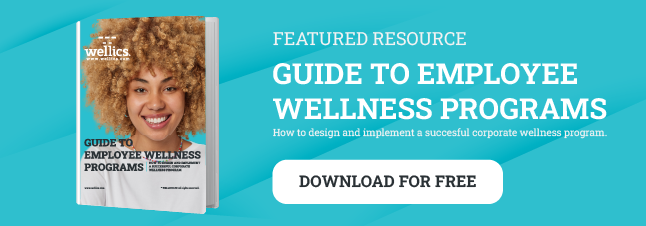We all know that physical activity is essential to good health. But do we know what types of activity are most beneficial? Research shows that simple daily tasks can contribute significantly to our total energy expenditure, which is an important consideration for workplace wellness programs.
When we increase our physical activity through routine tasks, we’re increasing a vital body process known as NEAT, which stands for non-exercise activity thermogenesis. Our guide to NEAT explains what it is, why it’s important, and how to increase your NEAT metabolism daily.
What Is NEAT?
Total energy expenditure consists of three components:
- Basal metabolic rate (BMR): Basal metabolism is the primary component of energy expenditure and is the amount of energy expended at rest in a temperature-neutral environment after fasting for about 12 hours. This component accounts for 60-70% of total energy expenditure in non-athletes. In other words, BMR is the energy the body needs to maintain vital processes, like breathing and blood circulation, while at rest.
- Diet-induced thermogenesis: Diet-induced thermogenesis accounts for 10-15% of total energy expenditure and provides the energy necessary to digest, absorb, and store food.
- Physical activity: The final and most inter and intra-variable component of total energy expenditure is physical activity, which accounts for 6-10% of total energy needs in non-athletes. It’s the amount of energy the body needs to perform all forms of physical activity, postural maintenance, and muscular contraction. This includes physical activity due to both exercise and non-exercise activity thermogenesis (NEAT).
NEAT is the energy we need for everything we do outside of sleeping, eating, or athletic exercise. It encompasses all activities of daily living other than exercise, like walking to work, typing, gardening, and taking the stairs. Even trivial physical activities increase metabolic rate substantially. A person’s daily NEAT is the cumulative impact of a multitude of different activities.
What Are the Benefits of Increasing Your NEAT?
NEAT is another way to count your physical activity apart from exercise. Basic body movements have many benefits similar to exercise, but the most known and well-established benefits of simple activity are the contribution to longevity and body weight management.
NEAT and Longevity
Some global regions are known to produce the longest living and healthiest people, often exceeding a life expectancy of 100 years, with many people being able to continue taking care of themselves well into their 90s. These regions are known as blue zones and are located worldwide.
Researchers have studied these populations and found similarities in how they live. Among them is that these people “move naturally.” They obtain sufficient exercise by doing daily chores, like gardening, washing dishes, sweeping, and grocery shopping, and not by hitting the gym. Everyday tasks like these are nothing more than NEAT activities.
NEAT and Weight Management
It’s well known that if someone wants to manage body weight, they must find a balance between energy input and output. Many people trying to lose weight increase their energy expenditure by exercising more. However, traditional “exercise” prescriptions don’t always successfully increase overall energy expenditure. This may be because either increased exercise also increases food intake or decreases energy expenditure for the rest of the day.
This phenomenon has been referred to as “compensation.” Some researchers have proposed that this compensation occurs by reducing one specific component of total energy expenditure — NEAT. Therefore, compensatory reduction in NEAT may explain how exercise interventions sometimes fail to promote weight loss, particularly where subjects have been reported to be less active during subsequent hours of the day, negating any increases in total energy expenditure.
On the other hand, it’s also been found that women who maintained weight had an average NEAT that was over 200 kcal/day higher (both after weight loss and one year later) than those who gained weight after one year, with no differences found in BMR between the two groups, highlighting the importance of NEAT in long-term weight maintenance.
Ways to Increase NEAT
The best way to approach NEAT is to think about your daily routine and how to increase activity within it.
Once a dermatologist said to me, “I see 50 patients daily. My office chair has wheels, so I roll to my patient to check on them. Instead of rolling, I started yesterday to stand. No extra time for exercise, and I do 50 stands instead of sitting during all of my shift!”. This is an excellent example of increasing activity within an existing routine.
Below are some ideas on how to increase NEAT, but it’s also important to find your own NEAT-increasing routines.
1. Take the Stairs
This is an easy way to increase your NEAT. One to three floors is not that hard, but what happens when your destination is higher? No problem. If you’re a beginner and come across six flights of stairs, simply start climbing and take the elevator once you feel tired. As you train yourself, things become easier.
2. Walk, Cycle, or Use Public Transport
In some countries or cities, like Ghent in Belgium, Stockholm in Sweden, or Trikala in Greece, most people use a bicycle as a means of transportation. Of course, not all cities are bicycle-friendly, but walking some distance and taking public transportation will add to your daily NEAT.
3. Park Farther Away and Walk
Not all places have the best public transportation system, or you may prefer to use your car to get around. However, you can still increase your NEAT by parking your car farther from your destination and walking the rest of the way.
4. Do Household Chores
This is an excellent way to increase your NEAT! Some people do all the cleaning once a week, some others do some on a daily basis. For example, ironing on Tuesdays and vacuuming on Thursdays. Find your own routine to increase your NEAT while getting your work done!
5. Stand More Than You Sit
Some companies have started using standing offices or standing meetings. Stand whenever you can, including when you’re waiting. Have a standing one-to-one meeting with your colleague, or just stand every hour for a few minutes to take a short break from work.
6. Take a Walking Break
As many of us have a sitting job that requires us to focus, there are days when we can get lost in our work and end up sitting for eight hours straight. This is not beneficial for our brain, posture, and heart health.
We recommend taking a short mental break every hour. If you’re in the middle of some important work, take a break every two hours, three times during your eight-hour workday. Decide based on what you are already doing. The point is to take multiple breaks so that you can stand or walk a few steps to get your blood moving, take a break from your screen, breathe deeply, and come back.
If you can also stretch a little bit, it’s even better for your posture and NEAT. Remember that every extra move counts!
7. Walk Around the Office
Just think of how many steps we are skipping during work by phoning, mailing, or asking for stuff to be transferred to us, like ordering coffee or asking a colleague to bring some water as they come from the vending machine.
If you’re e-mailing a remote colleague, it’s not as easy to visit in person, but think before you act! Can you go to your colleague’s office and ask for what you need instead of phoning them? Can you take five minutes to pour your own coffee or refill your water bottle? Can you pick a longer route? Can you take a bathroom break instead of ignoring your body when working hard to reach a deadline? Think of your daily work routine and decide beforehand the occasions when you can move more and get in some extra steps!
8. Walk to the Grocery Store
Walk instead of using your car to run errands or get groceries. Schedule a time in your week so you will not feel pressured and choose to skip it.
9. Walk to Meet Friends for Coffee
When you go for coffee with your friends, get there on foot or by bicycle. We tend to meet with friends on our days off, so you may have extra time to walk or bike to and from the cafe. So while you may have gone for coffee to have fun and relax, you also increased your NEAT at the same time!
So, sit less and live a long, healthy life!
Originally published September 20, 2022 - 7:36 AM, updated September 3, 2024
Sources:
- Buettner D & Skemp S. Blue Zones. Am J Lifestyle Med 2016;10(5): 318–321.
- Chung N, Park MY, Kim J et al. Non-exercise activity thermogenesis (NEAT): a component of total daily energy expenditure. J Exerc Nutrition Biochem 2018 Jun 30; 22(2): 23–30.
- Goldman L. “Obesity”, In Goldman-Cecil Medicine, 2020:207, 1418-1427.
- Malaeb S, Perez-Leighton CE, Noble EE, and Billington C. A “NEAT” Approach to Obesity. Prevention in the Modern Work Environment. Workplace Health Saf 2019 Mar;67(3):102-110.
- Pinheiro Volp AC, Esteves de Oliveira FC, Duarte Moreira Alves R, Esteves EA, Bressan J. Energy expenditure: components and evaluation methods. Nutr Hosp 2011;26(3):430-440.
- Schoeller DA, Shay K, Kushner RF. How much physical activity is needed to minimize weight gain in previously obese women? Am J Clin Nutr 1997; 66:551–556.
- Weinsier RL, Hunter GR, Desmond RA, Byrne NM, Zuckerman PA, Darnell BE. Free-living activity energy expenditure in women successful and unsuccessful at maintaining a normal body weight. Am J Clin Nutr 2002; 75:499–504.
- Weinsier RL, Hunter GR, Zuckerman PA, Darnell BE. Low resting and sleeping energy expenditure and fat use do not contribute to obesity in women. Obes Res 2003; 11(8):937–944.
- https://www.cambridge.org/core/journals/proceedings-of-the-nutrition-society/article/nonexercise-activity-thermogenesis/30B928A57E8A92BB87A89FA006DB5ACD
- https://archive.nutrition.org.uk/nutritionscience/obesityandweightmanagement/energy-intake-and-expenditure.html










